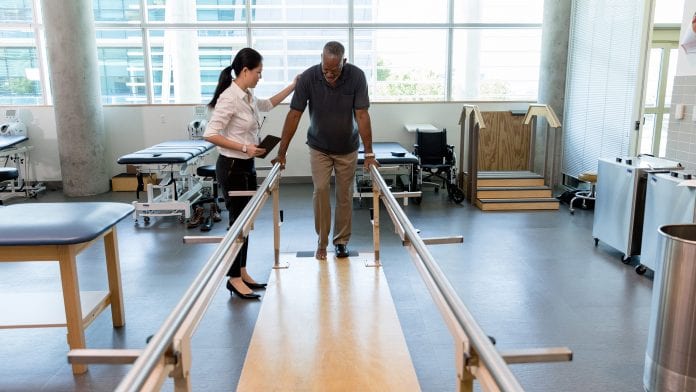
Training stroke survivors to walk at a faster speed during recovery can improve the brain’s ability to walk and think at the same time, new research has found.
Academics at Oxford Brookes University conducted a study, funded by the Stroke Association, to investigate the efficacy of rehabilitation approaches following a stroke. They found that learning to walk at a quicker speed as part of the recovery process helps improve the brain function that enables people to walk and perform another task simultaneously, known as dual-task walking.
The research paper, ‘Dual-task walking and automaticity after Stroke: Insights from a secondary analysis and imaging sub-study of a randomised controlled trial’, is published in Clinical Rehabilitation.
Walking training
Following a stroke, it is common for survivors to struggle with simultaneously walking and carrying out tasks that involve thinking, such as walking and holding a conversation. In order to regain this ability, rehabilitation approaches have focused directly on practicing walking and carrying out a thought-based task at the same time, known as dual-task training. However, a previous randomised controlled trial led by Oxford Brookes University and the University of Oxford found that this training was not any more effective in improving people’s ability to dual-task walk than just walking training.
Researchers believed that a reason why people struggle with dual-task walking after a stroke may be linked to their walking automaticity – the pattern our brains run which means we do not have to think about walking. This pattern is linked to the cyclic pattern of walking whereby one step ‘signals’ the next step to follow. If someone walks very slowly, this pattern could be disrupted so that walking becomes more like independent steps, rather than a cycle.
Faster walkers improved dual-task walking
Analysing the data from the previously run trial, researchers from Oxford Brookes University compared how people who walked slowly and people who walked at faster speeds responded to dual-task training.
Dr Johnny Collett, Senior Clinical Research Fellow in the Centre for Movement, Occupational and Rehabilitation Sciences at Oxford Brookes University, said: “When we compared slower walkers and people who walked at a faster pace – still slower, but closer to walking speeds we expect to see in people who have not had a stroke – both increased their walking speeds after the training. However, those who could walk faster at the beginning of the training also improved their ability to walk and think at the same time.”
Advanced brain imaging
As part of the new research, scientists at the University of Oxford used advanced imaging to track how people’s brains responded to the training. Changes found in the brain supported the findings that stroke survivors who walked slower had a less automatic control of walking. Those who walked at a faster pace had changes in the brain consistent with adaptations that may be necessary for controlling gait in more complex environments.
“These findings show that, for those who walk slowly, initially focusing on improving walking speed may increase their capacity to improve dual-task walking.
“Greater consideration of walking automaticity may help to better tailor intervention and direct a staged approach of increasing complexity to make people better able to walk in the community,” added Dr Collett.
Key to rehabilitation for stroke survivors
Dr Rubina Ahmed, Director for Research and Policy at the Stroke Association, said: “Stroke strikes every five minutes and has devastating physical and mental impacts. Whilst four out of five stroke survivors recover the ability to walk, most find it hard outside of hospital, which has a big impact on their wellbeing and independence. By funding this research, our charity has helped to highlight that training focused on walking speeds could be an important part of rehabilitation for some stroke survivors’ recoveries. Research like this is key to finding new treatments and improving stroke care, so that stroke survivors can regain the mobility and independence they need to rebuild their lives.”






















